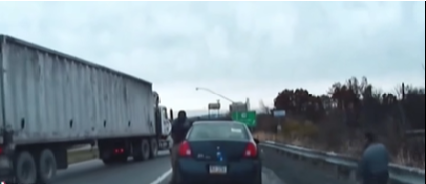It was just after dawn when the radio crackled to life. Deputy Lana Whitaker had barely started her first cup of coffee when dispatch came through:
“Construction crew near Morning Pines uncovered a buried vehicle. Looks like an old school bus. Tags match a cold case.”
Lana froze mid-sip, heart thudding. She didn’t need to ask which case—it had haunted her for decades. In 1986, she was a sick ten-year-old stuck at home, watching from her bedroom window as her classmates drove off for their end-of-year field trip. They never came back.
The drive to Morning Pines was smothered in fog, pine trees lining the road like sentries. As she passed the abandoned ranger station and turned down the overgrown camp road, memories stirred—cabin chatter, bonfires, Polaroid cameras, cassette players, cartoon-print backpacks.
By the time she arrived, workers had cordoned off the dig site. Yellow metal jutted from the dirt—faded, rusted, half-swallowed by time.
“We stopped digging when we saw the shape,” the foreman told her. “There’s something inside you’ll want to see.”
The back hatch had been forced open. A sickly, musty odor spilled out. Inside: silence, dust, and decay. Belts still clipped across empty seats. A pink lunchbox wedged under a bench. A moss-covered child’s sneaker on the step.
But no bones. No bodies. No answers.

At the front, taped to the dashboard in weathered handwriting: a class roster.
15 names. Ages 9 to 11.
Scrawled in red ink at the bottom: “We never reached Morning Pines.”
Lana stepped out into the cold, her breath fogging. Someone had been here recently. She ordered the site sealed and contacted the state investigators. Then she drove straight to the county archives.
The Hallstead Records building reeked of damp paper and citrus cleaner. After a long wait, the clerk emerged with a dusty box labeled:
Holstead Ridge Elementary – Grade 6B – May 1986
Inside: school portraits, trip permission slips, yearbook pages. And at the bottom, a final report:
“PRESUMED LOST – NO FOUL PLAY DETECTED.”
That label had echoed for nearly 40 years—unanswered, unexplained.
Back then, rumors had filled the silence.
The bus driver, Carl Davis, was new—barely vetted. He disappeared along with the vehicle.
The fill-in teacher, Ms. Atwell, left no paper trail. Her listed address was now an overgrown lot.
Some whispered of cult activity. Others, a lake accident. But no trace ever surfaced.
Until now.
The next break came unexpectedly. A woman was found near the dig site—barefoot, disoriented, severely dehydrated. A local couple spotted her wandering the forest.
“She keeps saying she’s twelve,” the nurse told Lana. “We thought she was hallucinating—until she gave us her name.”
Nora Kelly. One of the missing.
Lana entered the hospital room cautiously. The woman—hair tangled, skin pale—looked up at her with familiar green eyes.
“You got old,” Nora whispered, tears forming.
“You remember me?” Lana asked.
“Chickenpox. You were supposed to come.”
Lana sat beside her, heart pounding.
“They told us no one would look. No one remembered,” Nora murmured.
“Who told you that?”
Nora turned toward the window.
“We never made it to the lake.”
In the following days, memories returned—broken fragments Nora struggled to piece together.
Their driver wasn’t the regular one. A man met them along a side road.
“He said the lake wasn’t ready. We had to wait.”
She remembered a barn. Boarded windows. Clocks stopped at Tuesday. New names.
“Some forgot their old lives,” she said. “I didn’t.”
Her recollections led Lana to a property on County Line Road, once owned by a man named Avery.
In the tall grass: a child’s bracelet—Kimmy Leong’s.
Inside the barn: names carved into walls.
In a hidden compartment: Polaroids of children eating, sleeping, weeping—each labeled with new names like Dove, Quiet, and Glory.
That night, Lana returned to Nora, who recognized a photo.
“That was after our first winter,” she said. “They made us pose like a camp photo. That building—it’s where we were held the longest.”
Property records led Lana to a former campground—Riverview Retreat, purchased in 1984 by a mysterious foundation. She found the building. Outside: small footprints. Inside: a pale boy, no older than ten.
“I’m Jonah,” he said. “I don’t remember my old name. They took it away. Are you here to take me home?”
At the station, Jonah recognized old classmates in the yearbook: Marcy, Sam, even Lana herself.
“You were supposed to come,” he said. “You were lucky.”
Forensics recovered another photo from the bus—four children around a fire. A note scribbled on the back:
“He chose to stay.”
The boy in the photo was Aaron Develin, now living quietly in town under his real name. When confronted, he admitted:
“I stayed behind when the others fled. I believed in it. For a long time.”
Aaron led Lana to the ruins of the first hideout. Beneath broken beams: a tape recorder, a bracelet, a child’s drawing with five haunting words:
“We are still out here.”
Aaron pointed to a side trail. “That’s where they kept the youngest. After the fire, they called it Haven.”
Following it, Lana found a cedar tree split by lightning. Beneath its roots: a hidden entrance. Underground rooms. Painted walls. Makeshift beds. Learning spaces.
In the center: a steel box stamped:
“OBEDIENCE IS SAFETY. MEMORY IS DANGER.”
Behind another sealed door, Lana discovered a collage: old notes, a painted mural of a girl running through woods. One name repeated again and again: Cassia.
That name led to Maya Ellison—a quiet bookstore owner in town. When shown the mural, she broke down.
“I thought she was imaginary,” she whispered. “I didn’t think she was me.”
Over the following weeks, survivors were reunited—Nora, Kimmy, Maya. They remembered the lost years, their stolen identities. Some children had died. Others escaped. Many remained missing.
Now, by the lake that was never reached, a sign stands:
In Memory of the Fifteen
To those who vanished in silence—
Your names are known. Your stories remain.
You were never forgotten.
And in that quiet corner of Hallstead County, the long-buried truth finally surfaced.
No secret stays hidden forever.



